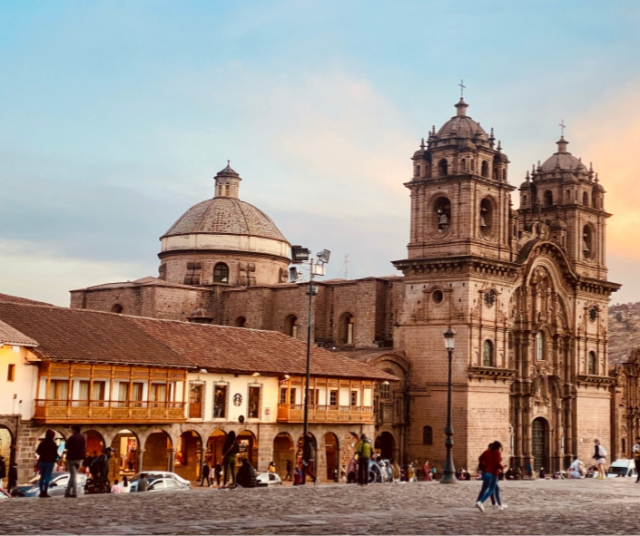Peru, a land of rich cultural diversity and ancient legacy, dresses in colors and traditions during the month of February. This month marks the beginning of a series of festivities that fuse the religious, the folkloric and the ancestral. Throughout the country, celebrations in February reveal the deep connection of the Peruvian population with their history, their indigenous roots and their religious beliefs.
The Cajamarca Carnival
The Cajamarca Carnival, which marks the beginning of the month of February in Peru, is presented as a vibrant explosion of joy, colors and traditions rooted in the rich history of this region. With deeply pre-Inca roots, this festival has evolved to become one of the country's most notable events, attracting locals and tourists alike.
The city of Cajamarca is transformed into a festive scene where the streets are filled with troupes, contagious music and traditional dances. The essence of Carnival is revealed in every corner, from the lively squares to the parades that run along the main avenues. Participants, dressed in colorful costumes and inventive masks, immerse themselves in an atmosphere of celebration that breaks down barriers between locals and visitors.
One of the distinctive characteristics of the Cajamarca Carnival is the active participation of the population, who enthusiastically engage in a friendly battle of water, foam and streamers. This tradition, which may seem chaotic to the uninitiated, is actually an expression of joy and disinhibition that seeks connection between people. Infectious laughter, improvised games and camaraderie define this aspect of Carnival, creating lasting memories for those who participate in this unique experience. In addition to unbridled fun, the Cajamarca Carnival also honors its cultural roots. Folk dances, passed down from generation to generation, occupy a central place in the festivities. The dancers' elaborate costumes and precise movements tell ancestral stories and represent the fusion of indigenous traditions with later influences. Carnival is not only a celebration of today, but also a bridge that connects the past with the present.
The Candlemas Festival in Puno
Puno, known as the folklore capital of Peru, lights up during the Candelaria Festival, a celebration that fuses Catholic elements with native traditions. This festival, which takes place at the beginning of February, is dedicated to the Virgin of Candelaria. The residents of Puno participate in impressive parades, dances and theatrical performances that tell the history of the region. The Diablada dance is especially notable, with its colorful costumes and masks that represent the fight between good and evil.
The Festival of the Virgin of Candelaria in Arequipa
The Festival of the Virgin of Candelaria in Arequipa emerges as a celebration that fuses deep religious devotion with the cultural wealth that characterizes this Peruvian city. In mid-February, the streets of Arequipa are filled with fervor and splendor, becoming the scene of a festivity that highlights the religious identity and cultural tradition of the region.
The festival is dedicated to the Virgin of Candelaria, a revered figure that attracts pilgrims and faithful from all over. The city dresses in its best clothes to welcome visitors, creating a vibrant atmosphere where faith and devotion are intertwined with joy and popular fervor.
The heart of the festivity lies in the processions that run through the streets of Arequipa. Beautifully decorated images of the Virgin of Candelaria are carried in solemn parades, accompanied by prayers, songs and expressions of faith. The crowd joins these processions, creating an emotional atmosphere that reflects the deep spiritual connection of the Arequipa community.
The churches, centers of devotion during this holiday, are decorated to welcome the faithful in special masses and religious ceremonies. Arequipa's colonial architecture provides a stunning setting for these celebrations, fusing the sacred with the historical.
The Ayacucho Carnival
The Ayacucho Carnival, celebrated with passion and color in the city of Ayacucho, stands as a vibrant expression of Peru's rich cultural tradition. This festival, which takes place in February, immerses the city in an atmosphere of festive joy, where music, dance and community celebration are the protagonists.
Ayacucho, known for its cultural diversity, transforms during Carnival into a stage where artistic expressions and local traditions intertwine. The event not only represents an occasion for unbridled fun, but also pays tribute to the cultural heritage that has endured through the centuries.
One of the most outstanding characteristics of the Ayacucho Carnival is the presence of troupes and folk dances. Participants, dressed in colorful costumes and elaborate masks, bring to life traditions that date back to ancient times. Among the most emblematic dances is the "huaylarsh", an artistic expression that fuses the Andean with the mestizo, creating a visual and sound spectacle that captivates spectators.
The Plaza Mayor of Ayacucho becomes the epicenter of the festivities, where parades and cultural presentations capture the essence of Carnival. The infectious rhythms of traditional music accompany the dances, creating an environment in which the community comes together to celebrate their unique cultural identity.
During the Ayacucho Carnival, the active participation of the population is evident in the famous "yunza". This tradition consists of planting a tree decorated with gifts in the main square. Participants dance around the tree and eventually try to tear it down to share the gifts. The "yunza" not only symbolizes togetherness and generosity, but also highlights the deep connection between the community and the land they inhabit.
These festivities are not only moments of joy and celebration, but also opportunities to preserve and transmit cultural expressions that have endured throughout the centuries. Thus, February becomes an emblematic month in the Peruvian calendar, where history, religiosity and identity are intertwined in a mosaic of unforgettable festivities.
